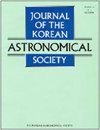Kmtnet超新星程序变量对象i . ngc2784场
IF 0.8
4区 物理与天体物理
Q3 ASTRONOMY & ASTROPHYSICS
引用次数: 2
摘要
本文介绍了KMTNet超新星计划对NGC 2784方向20平方度范围内约1250个可变源的分析。我们根据其b波段变异性将可变源分为三组。第一组由31个高变异性震源组成,其b波段均方根变异性大于0.3级。第二组中等变异性包含265个源,RMS变异性在0.05到0.3级之间。其余951个源属于第三组低变异性,RMS变异性小于0.05级。在全部约1250个源中,有4个源的变率周期明显大于100天,而其余源的周期短于约51天或没有可靠的周期。大多数源要么表现出相当不规则的变化,要么表现出短于2天的周期。在2至51天之间确定可靠周期的大多数来源属于低变异性组,尽管少数属于中等变异性组。所有周期大于35天的变源都非常红,B-V >为1.5等,V-I >为2.1等。我们对51颗造父变星、17颗半规则变星、3颗Mira型星、2颗RV(B)金牛星、26个食双星系统和1个活动星系核进行了分类。我们样本中的大部分长期变量属于Mira或半规则型,这表明在晚型恒星的后主序阶段,长期变异性可能更为突出。这26颗候选食双星的食倾深度相当于双星系统中两颗恒星的平均相对大小为~0.61。我们的结果说明了KMTNet超新星计划在未来研究可变天体方面的力量。本文章由计算机程序翻译,如有差异,请以英文原文为准。
KMTNET SUPERNOVA PROGRAM VARIABLE OBJECTS I. NGC 2784 FIELD
We present analyses of ~1250 variable sources identified in a 20 square degree field toward NGC 2784 by the KMTNet Supernova Program. We categorize the variable sources into three groups based on their B-band variability. The first group consists of 31 high variability sources with their B-band RMS variability greater than 0.3 magnitudes. The second group of medium variability contains 265 sources with RMS variability between 0.05 and 0.3 magnitudes. The remaining 951 sources belong to the third group of low variability with an RMS variability smaller than 0.05 magnitudes. Of the entire ~1250 sources, 4 clearly show periods of variability greater than 100 days, while the rest have periods shorter than ~51 days or no reliable periods. The majority of the sources show either rather irregular variability or short periods faster than 2 days. Most of the sources with reliable period determination between 2 and 51 days belong to the low-variability group, although a few belong to the medium-variability group. All the variable sources with periods longer than 35 days appear to be very red with B-V > 1.5 and V-I > 2.1 magnitudes. We classify candidates of 51 Cepheids, 17 semi-regular variables, 3 Mira types, 2 RV(B) Tauri stars, 26 eclipsing binary systems and 1 active galactic nucleus. The majority of long-term variables in our sample belong to either Mira or semi-regular types, indicating that long-term variability may be more prominent in post-main sequence phases of late-type stars. The depth of the eclipsing dips of the 26 candidates for eclipsing binaries is equivalent to ~0.61 as the average relative size of the two stars in the binary system. Our results illustrate the power of the KMTNet Supernova Program for future studies of variable objects.
求助全文
通过发布文献求助,成功后即可免费获取论文全文。
去求助
来源期刊

Journal of the Korean Astronomical Society
地学天文-天文与天体物理
CiteScore
1.30
自引率
10.00%
发文量
0
审稿时长
>12 weeks
期刊介绍:
JKAS is an international scientific journal publishing papers in all fields of astronomy and astrophysics. All manuscripts are subject to the scrutiny of referees. Manuscripts submitted to JKAS must comply with the ethics policy of JKAS. Six regular issues are published each year on February 28, April 30, June 30, August 31, October 31, and December 31. One year''s issues compose one volume.
 求助内容:
求助内容: 应助结果提醒方式:
应助结果提醒方式:


